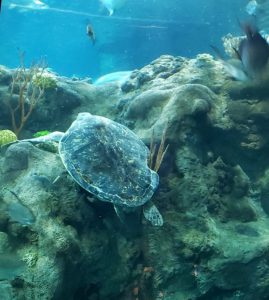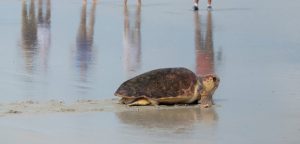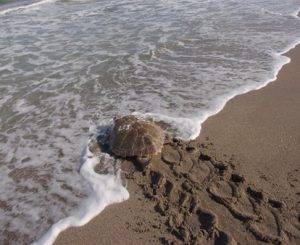Seven species of sea turtles swim in all of the world’s oceans except for the polar seas. Their adult lives at sea remain relatively unknown, but different species of sea turtles venture to shallow seagrass meadows while others dive to depths of 3,000 feet just for a meal!

Although not fast swimmers, sea turtles are the only turtles with true flippers that help them swim long distances and dive deep for their food. In Florida’s summer months, female sea turtles migrate thousands of miles back to sandy beaches to nest, sometimes to the same beach from which they hatched.
There are seven sea turtles species: loggerhead, green, leatherback, hawksbill, kemp’s ridley, olive ridley, and flatback. Only five of these species are commonly seen in Florida, but all five are listed as either threatened or endangered. Therefore, it is illegal to harm, harass, or kill any sea turtles, their eggs, or hatchlings. It is also illegal to import, sell, or transport turtles or their products.
Florida’s Five Sea Turtles
Leatherback Turtle (Dermochelys coriacea). Weighing in at a whopping 500 to 1,500 pounds and measuring up to 6 feet in length, the leatherback is the largest sea turtle. These divers venture deeper than any other air-breathing animal, except for sperm whales and elephant seals searching for their favorite cuisine – jellyfish! Unlike other sea turtles, the leatherback has a firm, leathery skin covering its flexible shell and allowing them to compensate for the changes in water pressure during the deep dives.
Loggerhead Turtle(Caretta caretta). Named for its massive, block-like head, the loggerhead is the most common sea turtle in Florida and the United States. Their powerful jaws do not have teeth but work great to crush clams and crabs. Compared to other sea turtles, loggerheads are slow. But do not let their slow speed fool you as they have great stamina and can travel long distances. They average about 3 feet in length and can weigh around 275 pounds.

Green Turtle(Chelonia mydas). Their love of consuming seagrasses and algae turns their body fat green – hence their name! During the day, green sea turtles graze shallow seagrass meadows and snooze on rock ledges at night. Although they are air-breathing reptiles, they can hold their breath for four to seven hours when resting. Because of their similar size, green sea turtles are often confused with loggerheads. However, green sea turtles can grow to be a tad bit larger.
Hawksbill Turtle(Eretmochelys imbricata)- The tortoise-patterned shell of the Hawksbill sea turtle was once used to make jewelry, bowls, and other decorations. This harvesting, unfortunately, contributed to the severely endangered status of the hawksbill sea turtle, and shell products are now banned. Hawksbills get their name from their raptor-like beak, and their jaws are perfect for snagging sponges when they need a tasty snack.
Kemp’s Ridley Turtle (Lepidochelys kempii) – The smallest Florida sea turtle and the rarest sea turtle in the world is the Kemp’s Ridley. It is the only one of the five that does not regularly nest in Florida but instead ventures to Rancho Nuevo on the Gulf Coast of Mexico to nest. Kemp’s also differ with their nesting behavior. The females all crawl onto the beach simultaneously and nest in broad daylight.
Nesting
Female sea turtles can be identified by the tracks left behind when they some on shore to nest. Photo credit: Tonya Long[/caption]Upon arrival, the female sea turtle must crawl ashore, dig a hole, lay her eggs, cover the eggs, and return to the sea. While it may sound simple, this is not an easy task for a 200+ pound female with flippers adapted for an aquatic environment. The female may return a couple of times and nest during the season, but she does not care for the eggs within the nest, nor will she nest every year.

The eggs’ temperature determines if the turtle will be male or female when it emerges. Eggs that incubate at cooler temperatures are males, and eggs kept at warmer temperatures will be female.
After two months, the new hatchlings will emerge all at once and make a run for the ocean! They typically do this at night when the sand is cooler, and there is a smaller chance of predators snatching them up during their dash. The new hatchlings rely on the moon’s reflection off the water to find their way back to the ocean. The males will never return to the shore again. The females will only return to nest.
Sometimes female sea turtles “cry” when they are laying their eggs in their nest, but this crying occurs when they are submerged in the water, too. This is because salt glands located behind a sea turtle’s eyes excrete salt. Therefore, when a sea turtle feeds, saltwater is ingested incidentally. This adaptation allows the sea turtle to keep the salt levels within the body at tolerable levels.

Threats
Unfortunately, sea turtles face many threats throughout their life. Natural hazards, such as hurricanes, can destroy nests, drown eggs, and deter females from nesting at all.
But sandcastles, moats, beach chairs, and artificial lighting are hazards, too. Items left behind or built on the beaches create obstacles for the already exhausted female sea turtle to maneuver around to nest. If the beach is not accessible, the female will return to sea without nesting. Instead, she may try to nest again on another night or release her fertilized eggs into the ocean where they cannot develop. In addition to the artificial lighting confusing sea turtle hatchlings, sandcastles and chairs can redirect the babies to crawl in the wrong direction. Large enough moats left behind can be dangerous to both the adult female and hatchlings.

How You Can Help
Sea turtles have many challenges ahead of them, and only one in 1,000 of the hatchlings will make it to adulthood. However, there are things you can do to help these threatened and endangered species survive.
1) Do not disturb sea turtle nests. Nests are usually marked off and dated by biologists and volunteers to prevent people from accidentally digging them up or stepping on them.
2) Observe hatchings and adult sea turtles from a distance. All five of Florida’s species are endangered or threatened. Harassment, touching, and obstructing can all come with hefty fines.
3) Before you go – smash those sandcastles and fill in the holes! Building sandcastles is a family-fun activity. Smashing them can be, too!
4) Clear the way: store chairs, umbrellas, and other items off the sandy beaches.
5) Be mindful of beach lighting during nesting season. Many hotels will have signs up about their light restrictions during the nesting seasons.
6) Volunteer! Look for a beach patrol group nearest you, or find a facility involved in the rescue, rehabilitation, and release of sea turtles.
7) And if you can’t volunteer – be sure to report any sick, injured, or dead sea turtles or suspicious activity to the Florida Fish and Wildlife Conservation commissions’ hotline. They will send out the appropriate biologist, volunteer, or law enforcement to help.
 0
0
